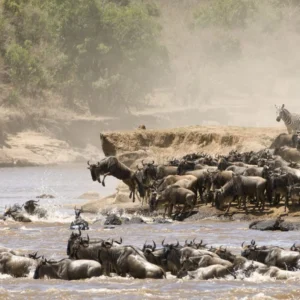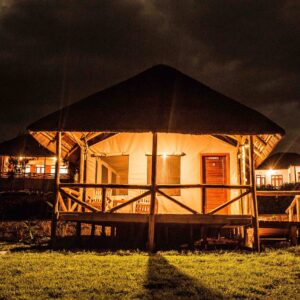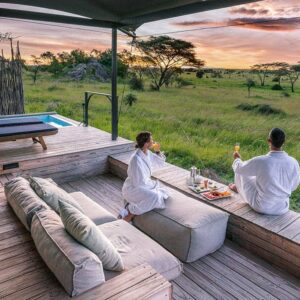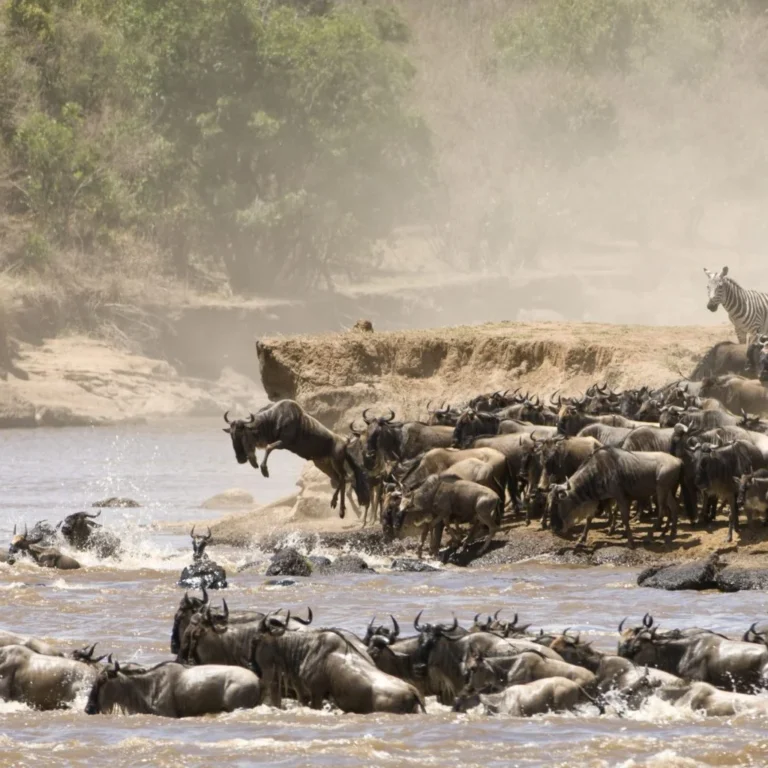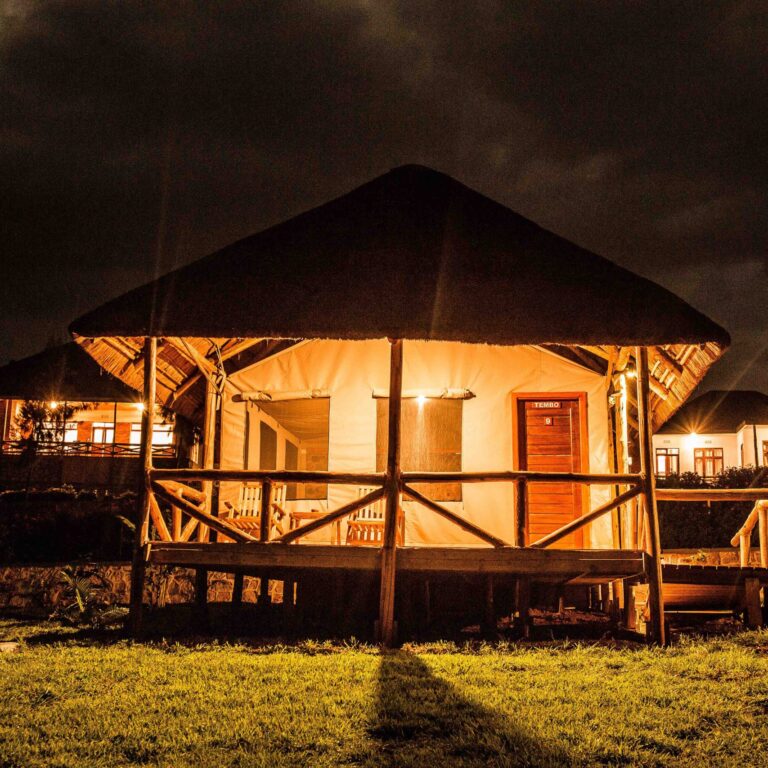When the term “safari” is mentioned, many people immediately picture the classic dry season image: parched, golden plains, dusty roads, and a relentless sun. This is the peak season, when water is scarce and animals congregate around shrinking waterholes, making them easier to spot. However, a growing number of seasoned travelers and photographers are deliberately choosing a different time to visit East Africa: the Green Season.
Often misunderstood as the “low season,” the Green Season is a period of dramatic transformation. It’s when the land, rejuvenated by the life-giving rains, bursts into a vibrant and lush paradise. While it may require a little more flexibility and a different packing list, the rewards are immense. Here are the top reasons why you should give the Green Season the green light for your next Tanzanian safari.
1. The Lush and Beautiful Scenery: A Photographer’s Dream
The most striking difference you’ll notice in the Green Season is the landscape itself. The dry, monochromatic hues give way to a stunning spectrum of emerald greens. The air, cleansed by the rain, is crystal clear, offering exceptional visibility. Dramatic, towering storm clouds create magnificent backdrops and spectacular sunsets, a photographer’s dream come true. The soft, golden light that breaks through the clouds after a shower is perfect for capturing stunning, moody, and vibrant wildlife photos. The scenery is simply breathtaking, a stark and beautiful contrast to the dusty plains of the dry season.
2. Excellent for Photography
Beyond the lush landscapes, the Green Season offers unique photographic opportunities. The combination of clear air, soft light, and dramatic skies provides the perfect canvas for professional and amateur photographers alike. Wildlife against a verdant background looks more vibrant and alive, and the added drama of the weather creates a sense of scale and power. You won’t just be taking photos of animals; you’ll be capturing stunning landscape art with wildlife as the centerpiece.
3. Fewer Crowds
This is a major advantage that cannot be overstated. During the Green Season, visitor numbers drop significantly. This means you can enjoy the national parks with a sense of peace and exclusivity. Imagine being the only vehicle at a lion sighting, with no other jeeps jostling for position. The animal sightings feel more intimate and personal, and you get to truly immerse yourself in the wilderness without the distraction of crowds. It’s a quieter, more serene experience that allows for a deeper connection with nature.
4. Special Offers and Lower Prices
As it’s considered the off-peak season, safari lodges, camps, and tour operators offer substantial discounts. The nightly rates can drop by as much as 70% in some cases, making a luxury safari more accessible or allowing you to extend your trip for the same budget. These special offers and deals mean you can stay in top-tier lodges and have a premium safari experience without the peak-season price tag. It’s a chance to treat yourself to a level of luxury that might otherwise be out of reach.
5. Abundant Wildlife and Baby Animals
The Green Season is a time of renewal, and this is especially true for the animal kingdom. The replenished water sources and fresh, nutritious grass create an ideal environment for breeding. This means you’ll witness a surge of new life across the plains. The period from January to March is known as the “calving season” in the Southern Serengeti and Ndutu, where hundreds of thousands of wildebeest and zebra give birth. This is a joyous and heartwarming sight, with wobbly-legged newborns adding an element of cuteness to every game drive.
6. Beginning of the Wildebeest Migration
The Green Season is not devoid of the Great Migration; it’s simply a different, and in many ways, more dynamic phase of it. From December to March, the massive herds of wildebeest and zebra congregate on the short-grass plains of the southern Serengeti and Ngorongoro Conservation Area for the calving season. This is the very beginning of their epic year-long journey. The sheer concentration of animals, coupled with the arrival of newborns, makes for incredible viewing and draws in a high concentration of predators.
7. Excellent Birdwatching
For avid birders, the Green Season is nothing short of a paradise. Migratory birds from Europe and Asia flock to East Africa, joining the resident species. The lush landscapes and abundance of insects provide a feast for countless birds. You’ll witness a spectacular array of colors and hear a symphony of calls. Even if you’re not a dedicated birdwatcher, the sheer diversity and beauty of avian life will captivate you.
8. Unique and Unforgettable Experience
A Green Season safari is a unique adventure. It requires a traveler who is flexible and embraces the natural world in its entirety. While there may be occasional rain showers, they often fall in the afternoon and are followed by clear, refreshing skies. The feeling of having the wilderness to yourself, witnessing new life, and experiencing the landscape in its most fertile state is a powerful and unforgettable experience. It’s a testament to the fact that a safari is not just about ticking off the Big Five, but about connecting with the rhythm of nature.
9. What Makes a Green Safari Special?
A Green Season safari is special because it offers an authentic and immersive experience. You get to see the interconnectedness of the ecosystem in action—the rains bring new growth, which attracts herbivores, which in turn leads to a concentration of predators. You witness the full circle of life, from birth to the thrilling hunts that define survival on the plains. It’s not just a spectacle of animals but a deep dive into the delicate balance of an entire ecosystem.
10. Pros & Cons of a Green Season Safari
Pros:
- Lower Prices & Special Offers. Significant savings on flights, accommodations, and tours.
- Fewer Crowds. Enjoy more exclusive game viewing without vehicle congestion.
- Lush Landscapes. Stunning scenery with vibrant greenery, wildflowers, and dramatic skies.
- Excellent Photography. Perfect light and backdrops for stunning photos.
- Baby Animals. Witness the calving season and an abundance of newborns.
- Birdwatching. A paradise for migratory and resident bird species.
- More Available Guides and Lodges. Greater flexibility for last-minute bookings.
Cons:
- Rain. Afternoon showers are common, which can make roads muddy.
- Thicker Vegetation. Taller grass and leaves can make spotting some animals more challenging.
- More Insects. The wet weather can lead to more mosquitoes and other insects.
- Some Lodges Close. Some remote camps may close for the season due to inaccessibility.
When is the Safari Green Season in East Africa?
The safari green season in East Africa generally falls between November and May, with distinct short rains in November/December and long rains in April/May. This period is characterized by lush greenery, fewer crowds, and potential for lower safari costs, making it an attractive time to visit. The Green Season in East Africa generally runs from November to May. It is often broken down into two distinct periods:
The “Short Rains” (November – December). Characterized by short, sporadic afternoon thunderstorms.
The “Long Rains” (March – May): The heaviest rains occur during this period, with April and May often seeing the most consistent rainfall.
A “Mini-Dry” Season (January – February). A dry spell between the two rainy seasons, this is a particularly excellent time to visit, as the landscape is still lush but with less rain.
Where to Stay in the Green Season
While some tented camps may close during the heaviest rains, many luxury lodges and permanent camps remain open year-round. It’s recommended to choose lodges with solid structures rather than just canvas tents.
Ngorongoro Crater. The wildlife in the crater stays year-round, making it an excellent Green Season destination. The lush scenery and fewer crowds enhance the experience. Southern Serengeti/Ndutu. This is the prime location from January to March to witness the calving season. Mobile camps in this area move with the herds, ensuring you’re always in the heart of the action. Tarangire National Park. While the wildebeest population diminishes, Tarangire remains a great spot for elephant sightings, especially in the early Green Season.
Serengeti Serena Safari Lodge or Ngorongoro Serena Safari Lodge are examples of lodges that offer significant discounts and remain open and accessible during this time.
What to Pack During the Green Season Safari?
During the green season safari, pack clothing in neutral colors like khaki, beige, or olive green, along with a waterproof jacket and comfortable walking shoes or hiking boots. Don’t forget essentials like sunscreen, insect repellent, a hat, and binoculars for game viewing.
Packing for the Green Season is similar to the dry season but with a few key additions:
Lightweight Rain Jacket. Essential for afternoon showers. Choose one that is breathable and easy to pack. Quick-Drying Clothes. Opt for synthetic fabrics or a lightweight cotton that dries quickly. Layers. A fleece or light jacket for cool mornings and evenings, and long-sleeved shirts for sun and insect protection. Waterproof Bag. A waterproof cover for your camera and daypack is crucial to protect your gear. Waterproof Shoes. Closed-toed shoes that can handle a little mud are a must. Insect Repellent. A strong insect repellent with DEET is highly recommended. Neutral Colors. Stick to khaki, tan, green, and brown to blend in.
Plan Your Visit: Tips for Low Season Travel in Tanzania
- Pack for changing weather: Include waterproof clothing, gaiters, and layered outfits.
- Book with reputable tour operators familiar with off-season travel logistics.
- Be flexible with your schedule to take advantage of breaks in the weather for game drives or hikes.
- Consider internal flights to avoid long, muddy road trips.
- Support community-based tourism for more impactful, sustainable travel.

